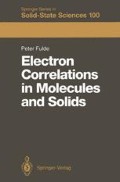Abstract
When excited states are considered and excitation energies are calculated, a quantitative treatment of electron correlations becomes vital. The point is that the correlation-energy contribution to the ground-state energy may be small compared with the dominating contributions of the self-consistent field; however, when energy differences with respect to the ground state are calculated, the changes in the correlation energy may become equal to or even larger than those resulting from changes in the self-consistent field. For example, in a semiconductor (or insulator) like diamond, the energy gap for exciting an electron from the valence into the conduction band is reduced by a factor of 1/2 due to correlations (Chap. 9).
Access this chapter
Tax calculation will be finalised at checkout
Purchases are for personal use only
Preview
Unable to display preview. Download preview PDF.
Chapter 6
P.J. Bruna, S.D. Peyerimhoff: In Ab Initio Methods in Quantum Chemistry, Part I, ed. by K.P. Lawley (Wiley, New York 1987)
F.B. Brown, I. Shavitt, R. Shepard: Chem. Phys. Lett. 105, 363 (1984)
N.C. Handy, P.J. Knowles, K. Somasundram: Theor. Chim. Acta 68, 87 (1985)
S. Prime, C. Rees, M.A. Robb: Mol. Phys. 44, 173 (1981); for a simplified version see E.R. Davidson: In The World of Quantum Chemistry, ed. by R. Daudel, B. Pullman (Reidel, Dordrecht 1974)
A.A. Abrikosov, L.P. Gorkov, I.E. Dzyaloshinski: Methods of Quantum Field Theory in Statistical Physics (Prentice-Hall, Englewood Cliffs, NJ 1963)
E.K.U. Gross, E. Runge: Vielteilchentheorie (Teubner, Stuttgart 1986)
G.C. Wick: Phys. Rev. 80, 268 (1950)
J.R. Schrieffer: Theory of Superconductivity (W.A. Benjamin, Reading, MA 1964)
G.D. Mahan: Many Particle Physics (Plenum, New York 1981)
A.L. Fetter, J.D. Walecka: Quantum Theory of Many-Particle Systems (McGraw-Hill, New York 1971)
R. Zwanzig: In Lectures in Theoretical Physics, Vol. 3 (Interscience, New York 1961)
H. Mori: Prog. Theor. Phys. 33, 423 (1965)
Author information
Authors and Affiliations
Rights and permissions
Copyright information
© 1991 Springer-Verlag in Berlin Heidelberg
About this chapter
Cite this chapter
Fulde, P. (1991). Excited States. In: Electron Correlations in Molecules and Solids. Springer Series in Solid-State Sciences, vol 100. Springer, Berlin, Heidelberg. https://doi.org/10.1007/978-3-642-97309-3_6
Download citation
DOI: https://doi.org/10.1007/978-3-642-97309-3_6
Publisher Name: Springer, Berlin, Heidelberg
Print ISBN: 978-3-642-97311-6
Online ISBN: 978-3-642-97309-3
eBook Packages: Springer Book Archive

